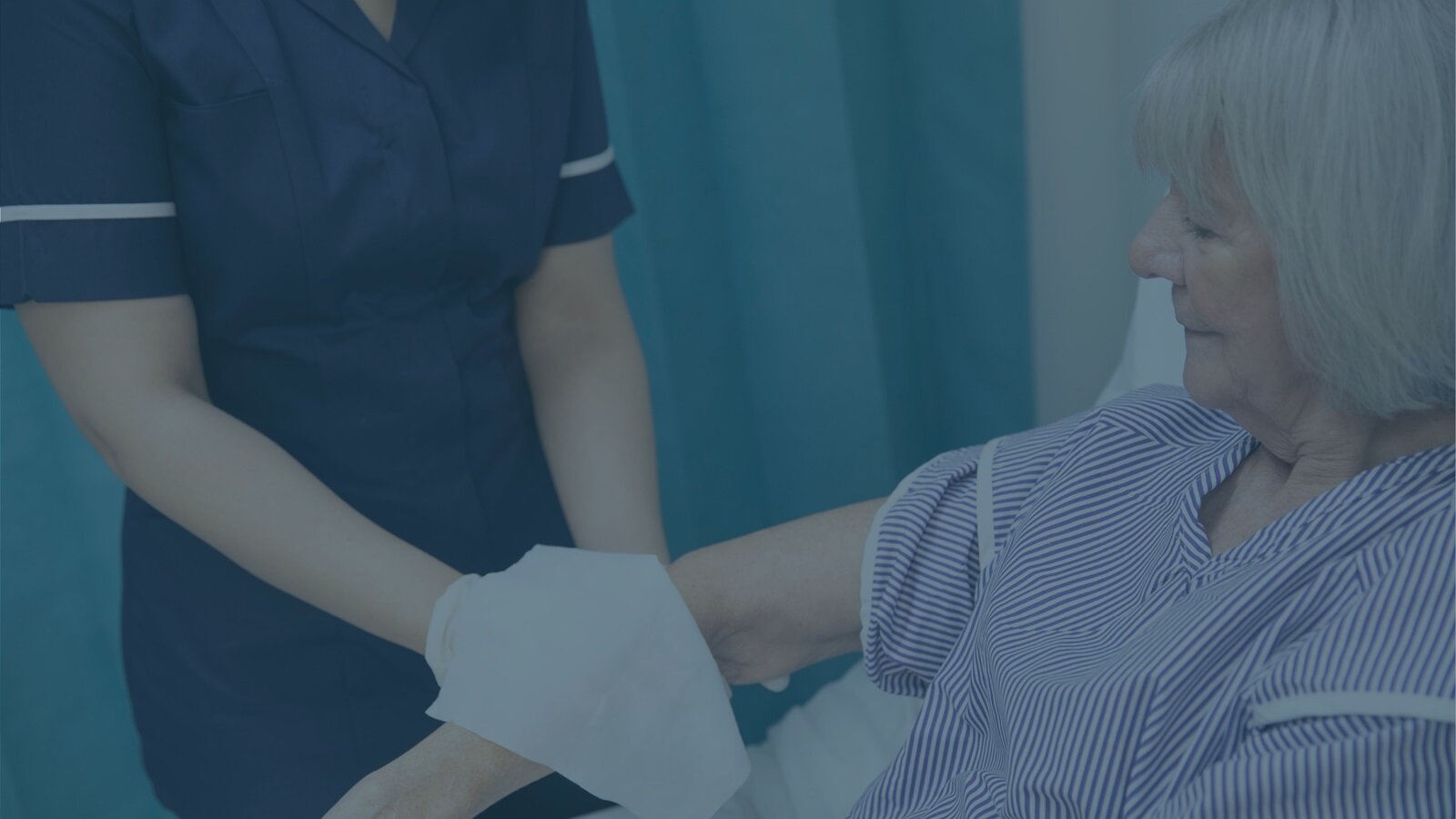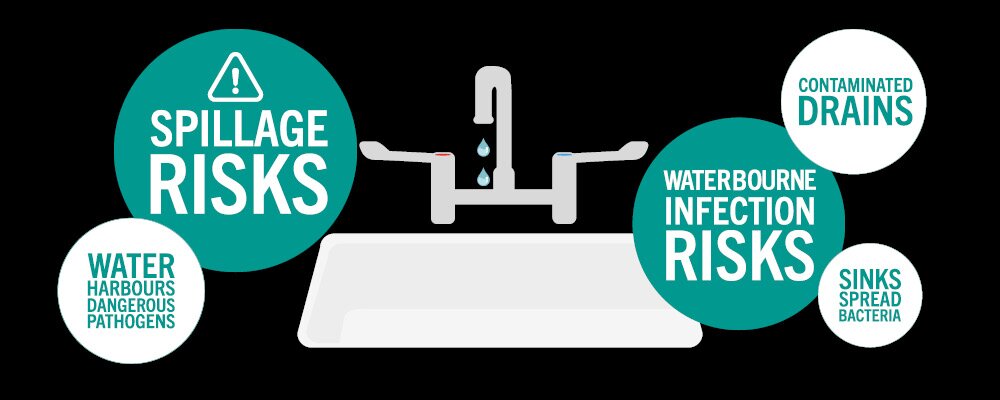
Turning the tide: Waterless Bathing and Infection Control

Turning the tide: Waterless Bathing and Infection Control
Healthcare-associated infections (HCAIs) compromise patient safety, contribute to antimicrobial resistance, and lead to excess costs the NHS can ill afford.1
While risk mitigation measures focus on a wide range of factors, one important and ubiquitous source of potential infection is often overlooked: water systems. Taps, sinks, and pipes can harbour dangerous pathogens, making the very act of patient hygiene a counter-intuitive infection risk.2
One innovative solution is the use of waterless bathing. By replacing traditional water-based washing with pre-moistened wipes and rinse free cleansers, hospitals can significantly decrease the risk of contamination and infection spread, enhancing safety and reducing costs.
HCAI: Prevalence and impact
HCAIs, or infections that occur while receiving healthcare, can develop either as a direct result of healthcare inventions, or from being in contact with the healthcare setting itself. They are a significant problem. In 2016/18, there were an estimated 635,000 HCAIs among 3.8 million adult inpatients in NHS general and teaching hospitals in England alone.3
This is not surprising when we consider the risk factors. In-patients are uniquely vulnerable to infection. They may have underlying health conditions or be taking immunosuppressant medications, while also sharing facilities with people experiencing infectious disease.
The consequences are multifaceted, and they include the worse patient outcomes – up to and including increased mortality. In 2016/17, for example, a staggering 22.800 people died as a result of a HCAI.3
In addition, higher numbers of infections lead to the increased use of antibiotics, which in turn promotes antimicrobial resistance (AMR).4 The World Health Organisation (WHO) has listed AMR, which occurs when microbes evolve mechanisms that protect them from the effects of antimicrobials, as one of the top ten threats to global health.5
HCAIs also contribute to higher healthcare costs. They were associated with 5.6 million extra night bed stays in 2016/17, as well as 62,000 days of absenteeism among the 13,900 healthcare staff who contracted an infection while at work. That added up to an estimated costs to the NHS of £2.1 billion, 99.8% of which was attributed to patient management with the remainder being spent on replacing absent front-line healthcare staff.3
HCAIs and water
Luckily, many HCAIs are preventable with the right infection control measures in place. Simple approaches, such as robust hand hygiene, environmental cleanliness, and following standard sterile techniques can all help reduce the spread of infection.
One area often overlooked, however, is water systems. We have known that sinks can be a source of infection since the 1970s,6 a finding that has been replicated countless times.
A 2009 study (Johnson, D. et al), for example, found that 98% of 92 analysed wash basins in hospital settings contained bacteria. The authors concluded that sinks were a “reservoir for bacteria” and “may be a source of transmission of HCAIs”.7 Another study, published in 2012, found 62.2% of 1,103 basins were contaminated with common healthcare-acquired pathogens.8 This data matters because healthcare settings are prolific water users, with some estimates putting use at 450L per patient per day.9 Yet this water, which is used to wash vulnerable patients, harbours dangerous pathogens – pathogens that can move from water systems to bedside with ease.


The real-world implications are significant. In 2019, a multi-drug-resistant Pseudomonas aeruginosa outbreak was recorded in three intensive care units (ICUs) of a Swiss university hospital. Environmental sampling detected the outbreak strain in nine samples of sink siphons of the units, which shared a common water sewage system, and on one gastroscope. The sink siphons were replaced, but three weeks later the strain was once again present in samples, and new infections were identified.10
The outbreak was only contained after all sinks in the proximity of patients and medication preparation areas were removed and tap water use was minimised. By this point, however, 29 patients had developed the infection, which contributed to the death of nine of them.10
Waterless Bathing
As the Swiss example demonstrates, minimising water use is an effective method of reducing the risks associated with waterbourne infections in healthcare settings. Waterless bathting is an important, evidence-based part of this strategy.11
A 2017 study (Hopman,J et al) looked at the impact of removing sinks from ICU patient rooms and introducing ‘water-free’ patient care on gram-negative bacilli (GNB) colonisation rates. It found a significant reduction of patient colonisation with GNB, particularly among those with a longer ICU length of stay.11
Many products that allow teams to replace soap and water with confidence are now available. They include bed bathing washcloths that contain a pH-balanced formula designed to cleanse and condition, whilst also increasing skin moisturisation. Rinse free shampoo caps, pre-impregnated with cleansers and conditioners, release a rinse formulation into the hair when massaged, and retain oil and dirt in the hydrophilic fabric.
In the past, there has been some concern that such products pose an infection control risk after use, and around the environmental impact of their disposal. Today’s innovative products have expunged these worries. Many are compatible with on-site maceration and have been designed with negligible amounts of plastic, meaning they can be disposed of quickly, hygienically, and with minimal environmental impact.
Waterless bathing, then, is an evidence-based approach to tackling HCAIs, and can help hospitals and other healthcare settings to protect patient safety, slow AMR, and reduce costs.
Replace soap and water practices
with Conti® Waterless Bathing
Helping to prevent healthcare-associated infections with rinse free bathing.
References:
1. NHS England. Healthcare associated infections. [online] Access at: https://www.england.nhs.uk/patient-safety/healthcare-assoTaps,%20sinks,%20and%20pipes%20can%20harbour%20dangerous%20pathogens,%20making%20the%20very%20act%20of%20patient%20hygiene%20a%20counter-intuitive%20infection%20risk.ciated-infections/ Last accessed: 09th October 2024.
2. Legionella Contol. Can Hospital Sinks Harbour Dangerous Bacteria? [online] Access at: Can Hospital Sinks Harbour Dangerous Bacteria? (legionellacontrol.com) Last accessed: 09th October 2024.
3. Guest, J. F., Keating, T., et al. (2020). Modelling the annual NHS costs and outcomes attributable to healthcare-associated infections in England. BMJ open, 10(1), e033367.
4. Abban, M. K., Ayerakwa, E. A., et al. (2023). The burden of hospital acquired infections and antimicrobial resistance. Heliyon.
5. Walsh, T. R., Gales, A. C., et al. (2023). Antimicrobial resistance: addressing a global threat to humanity. PLoS medicine, 20(7), e1004264.
6. Teres, D. (1973). Pseudomonas in sinks, not taps. Lancet (London, England), 1(7810), 1001-1001.
7. Johnson, D., Lineweaver, L., et al. (2009). Patients’ bath basins as potential sources of infection: a multicenter sampling study. American Journal of Critical Care, 18(1), 31-40.
8. Marchaim, D., Taylor, A. R., et al. (2012). Hospital bath basins are frequently contaminated with multidrug-resistant human pathogens. American journal of infection control, 40(6), 562-564.
9. Department of Health. (2013). Environment and sustainability Health Technical Memorandum 07-04: Water management and water efficiency – best practice advice for the healthcare sector. Available at: https://www.england.nhs.uk/wp-content/uploads/2021/05/HTM_07-04_Final.pdf Last accessed: 28th August 2024.
10. Schärer, V., Meier, M. T., et al. (2023). An intensive care unit outbreak with multi-drug-resistant Pseudomonas aeruginosa–spotlight on sinks. Journal of Hospital Infection, 139, 161-167.
11. Hopman, J., Tostmann, A., et al. (2017). Reduced rate of intensive care unit acquired gram-negative bacilli after removal of sinks and introduction of ‘water-free’ patient care. Antimicrobial Resistance & Infection Control, 6, 1-9.
[LL1]Please fix the bibliography references list.